Design and Study of Physical and Mechanical Properties of Concrete Based on Ferrochrome Slag and Its Mechanism Analysis
Abstract
:1. Introduction
2. Materials and Methods
2.1. Materials
2.1.1. Cement
2.1.2. Ferrochrome Slag Powder
2.1.3. Ferrochrome Slag Fine Aggregate
2.1.4. Natural Fine Aggregates
2.1.5. Coarse Aggregate
2.1.6. Water and Superplasticizer
2.2. Experimental Methods
2.2.1. Mixture Design and Specimen Preparation
2.2.2. X-ray Diffraction Study
2.2.3. Thermogravimetric and Differential Scanning Calorimetric Analyses
2.2.4. Scanning Electron Microscopy Analysis
3. Results
3.1. Fluidity and Compressive Strength of Cement Mortar
3.2. SEM and XRD Analysis
3.3. Study of Basic Properties of Ferrochrome-Slag-Based Low-Carbon Concrete
3.3.1. Slump and Compressive Strength
3.3.2. Water Absorption
3.3.3. SEM Analysis
3.3.4. TG-DSC Analysis
4. Conclusions
- (1)
- The effect of ferrochrome slag powder on the strength and fluidity of cement mortar was examined in this study. It was determined that there is a process of water absorption and loss in cement mortar. Due to the porous structure and water-reducing effect of ferrochrome slag powder, the fluidity of cement mortar can be adjusted and the compressive strength can be improved by adding 15% ferrochrome slag powder.
- (2)
- The microstructure analysis indicated that the dissolution of active components in ferrochrome slag powder promotes the transformation from AFt to AFm. Active Al2O3 and SiO2 react with Ca(OH)2 to form C-S-H and C-A-S-H gels. The ferrochrome slag powder can effectively fill the pores between the hydration products to improve the compressive strength of mortar. The Mg element in ferrochrome slag powder mainly exists in the cement mortar system as magnesium olivine and spinel mineral phases with a stable structure, which does not cause problems for system stability.
- (3)
- The workability, compressive strength, and water absorption of ferrochrome-slag-based concrete were studied. It was found that ferrochrome slag used as aggregate can reduce the fluidity of concrete under the same mix proportions; however, the compressive strength of ferrochrome-slag-based concrete is higher than that of conventional concrete. Ferrochrome slag can reduce the water absorption of concrete and improve the compressive strength of concrete. This study provides a reference for the application of water-cooled ferrochrome slag as fine aggregate and air-cooled ferrochrome slag as coarse aggregate in practical engineering.
- (4)
- TG-DSC and SEM analyses revealed that when ferrochrome slag is used as concrete aggregate, the interface bonding properties between aggregate and paste can be improved because of the porous structure of ferrochrome slag.
- (5)
- This study found that water-cooled high-carbon ferrochrome slag powder can be used as an auxiliary cementitious material. When the substitution amount of chromite slag powder is 15%, the compressive strength of the ferrochrome-slag-cement composite rubber material is the highest. This study provides a reference for the use of water-cooled high-carbon ferrochrome slag as a supplementary cementitious material in practical engineering.
Author Contributions
Funding
Institutional Review Board Statement
Informed Consent Statement
Data Availability Statement
Conflicts of Interest
References
- Kumar, B.A.V.R.; Keshav, L.; Sivanantham, P.A.; Arokiaraj, G.G.V.; Rahman, D.R.Z.; Kumar, P.M.; Somashekar, D. Comprehensive Characterization of Ferrochrome Slag and Ferrochrome Ash as Sustainable Materials in Construction. J. Nanomater. 2022, 2022, 12. [Google Scholar] [CrossRef]
- Xie, H.Z.; Li, L.G.; Liu, F.; Kwan, A.K.H. Recycling Old Concrete as Waste Concrete Powder for Use in Pervious Concrete: Effects on Permeability, Strength and Eco-Friendliness. Buildings 2022, 12, 2172. [Google Scholar] [CrossRef]
- Suryaningrat, E.R.; Kimsan, M.; Pramono, B.; Masud, F.; Sriyani, R. Effect of ferronickel slag in concrete and mortar. Mag. Civ. Eng. 2022, 109, 1–13. [Google Scholar]
- Das, P.; Cheela, V.R.S.; Mistri, A.; Chakraborty, S.; Dubey, B.; Barai, S.V. Performance assessment and life cycle analysis of concrete containing ferrochrome slag and fly ash as replacement materials-A circular approach. Constr. Build. Mater. 2022, 347, 128609. [Google Scholar] [CrossRef]
- Bin, T.T.; Tafaghodi, K.L. Chromium Stabilization in Ferrochrome Slag for its Utilization as Aggregate Material. J. Sustain. Metall. 2022, 8, 1041–1052. [Google Scholar]
- Liu, B.Y.; Yang, Y.F.; Bo, Y.; Huang, Q. Research status and development trend of resource utilization technology of ferrochrome slag. Environ. Eng. 2016, 34, 679–683. [Google Scholar]
- Yang, F.; Jia, L.J.; Jiang, Y. Application of ferrochrome slag in concrete. Bull. Chin. Silic. Soc. 2017, 36, 1907–1910. [Google Scholar]
- Fares, A.I.; Sohel, K.; Al-Jabri, K.; Al-Mamun, A. Characteristics of ferrochrome slag aggregate and its uses as a green material in concrete-A review. Constr. Build. Mater. 2021, 294, 123552. [Google Scholar] [CrossRef]
- Das, S.; Patra, R.K.; Mukharjee, B.B. Feasibility study of utilisation of ferrochrome slag as fine aggregate and rice husk ash as cement replacement for developing sustainable concrete. Innov. Infrastruct. Solut. 2021, 6, 85. [Google Scholar] [CrossRef]
- Prasanna, K.A.; Sanjaya, K.P. Use of ferrochrome ash (FCA) and lime dust in concrete preparation. J. Clean. Prod. 2016, 131, 237–246. [Google Scholar]
- Karakoç, M.B.; Türkmen, İ.; Maraş, M.; Kantarci, F.; Demirboğa, R.; Toprak, M.U. Mechanical properties and setting time of ferrochrome slag based geopolymer paste and mortar. Constr. Build. Mater. 2014, 72, 283–292. [Google Scholar] [CrossRef]
- Panda, C.; Biswal, S.S.; Dash, P.; Jena, T.; Panda, K.C.; Sahu, D. Study of Ferrochrome immobilization behavior in unbound and concrete bound ferrochromium slag. J. Mater. Cycles Waste Manag. 2022, 24, 528–539. [Google Scholar] [CrossRef]
- Khan, M.I.; Almesfer, M.K.; Elkhaleefa, A.M.; Aamary, A.; Ali, I.H.; Shamim, M.Z.; Shoukry, H.; Rehan, M. Efficient adsorption of hexavalent chromium ions onto novel ferrochrome slag/polyaniline nanocomposite: ANN modeling, isotherms, kinetics, and thermodynamic studies. Environ. Sci. Pollut. Res. Int. 2022, 29, 86665–86679. [Google Scholar] [CrossRef] [PubMed]
- Sudhansu, S.B.; Chittaranjan, P.; Sudarsan, S.; Jena, T.; Panda, K.C. Assessment of factors influencing the elution of ferrochrome from ferrochromium slag using factorial design of experiment. Mater. Today Proc. 2021, 35, 97–101. [Google Scholar]
- Chethan, K.B.; Subhash, C.Y.; Das, B.B. Ferrochrome ash—Its usage potential in alkali activated slag mortars. J. Clean. Prod. 2020, 257, 120577. [Google Scholar]
- Rosales, J.; Cabrera, M.; Agrela, F. Effect of stainless steel slag waste as a replacement for cement in mortars. Mechanical and statistical study. Constr. Build. Mater. 2017, 142, 444–458. [Google Scholar] [CrossRef]
- Yaragal, S.C.; Kumar, B.C.; Jitin, C. Durability studies on ferrochrome slag as coarse aggregate in sustainable alkali activated slag/fly ash based concretes. Sustain. Mater. Technol. 2020, 23, e00137. [Google Scholar] [CrossRef]
- Dash, M.K.; Patro, S.K. Performance assessment of ferrochrome slag as partial replacement of fine aggregate in concrete. Eur. J. Environ. Civ. Eng. 2018, 25, 635–654. [Google Scholar] [CrossRef]
- Xue, S.N. Experimental study on concrete made of high carbon ferrochrome slag instead of natural aggregate. People’s Yangtze River 2022, 53, 107–110+137. [Google Scholar]
- Yang, F.; Sun, X.M. Application of high carbon ferrochrome slag in experimental study of C40 concrete. Iron Steel Vanadium Titan. 2021, 42, 119–124. [Google Scholar]
- Manoj, K.D.; Sanjaya, K.P. Effects of water cooled ferrochrome slag as fine aggregate on the properties of concrete. Constr. Build. Mater. 2018, 177, 457–466. [Google Scholar]
- Sanghamitra, J.; Ramakanta, P. Feasibility study of the properties of geopolymer concrete with ferrochrome slag and silica fume. Mater. Today Proc. 2020, 38, 2476–2480. [Google Scholar]
- Sanghamitra, J.; Ramakanta, P. Performance assessment of geopolymer concrete with partial replacement of ferrochrome slag as coarse aggregate. Constr. Build. Mater. 2019, 220, 525–537. [Google Scholar]
- Ashish, K.S.; Prabir, K.S. Sustainable use of ferronickel slag fine aggregate and fly ash in structural concrete: Mechanical properties and leaching study. J. Clean. Prod. 2017, 162, 438–448. [Google Scholar]
- Hansol, K.; Chang, H.L.; Ki, Y.A. Feasibility of ferronickel slag powder for cementitious binder in concrete mix. Constr. Build. Mater. 2019, 207, 693–705. [Google Scholar]
- Luca, R.; Guido, B.; Sabrina, S.; Cominoli, L.; Collivignarelli, C.; Plizzari, G. Concrete with EAF steel slag as aggregate: A comprehensive technical and environmental characterization. Compos. Part B Eng. 2016, 90, 195–202. [Google Scholar]
- Al-Jabri, K.; Shoukry, H. Influence of nano metakaolin on thermo-physical, mechanical and microstructural properties of high-volume ferrochrome slag mortar. Constr. Build. Mater. 2018, 177, 210–221. [Google Scholar] [CrossRef]
- Dash, M.K.; Patro, S.K.; Acharya, P.K.; Dash, M. Impact of elevated temperature on strength and micro-structural properties of concrete containing water-cooled ferrochrome slag as fine aggregate. Constr. Build. Mater. 2022, 323, 126542. [Google Scholar] [CrossRef]
- Kaish, A.B.M.A.; Odimegwu, T.C.; Zakaria, I.; Abood, M.M. Effects of different industrial waste materials as partial replacement of fine aggregate on strength and microstructure properties of concrete. J. Build. Eng. 2021, 35, 102092. [Google Scholar] [CrossRef]
- Hui, S.M. Study on Preparation and Chloride Ion Corrosion Resistance of All-Solid Waste Concrete Mixed with Alkali Slag for Marine Engineering; University of Science and Technology Beijing: Beijing, China, 2022. [Google Scholar]
- Huang, S.Y.; Huo, B.B.; Chen, C.; Zhang, Y.M. Effect of metakaolin on hydration of steel slag cement-based composite system under steam curing conditions. Mater. Rep. 2022, 36, 73–78. [Google Scholar]
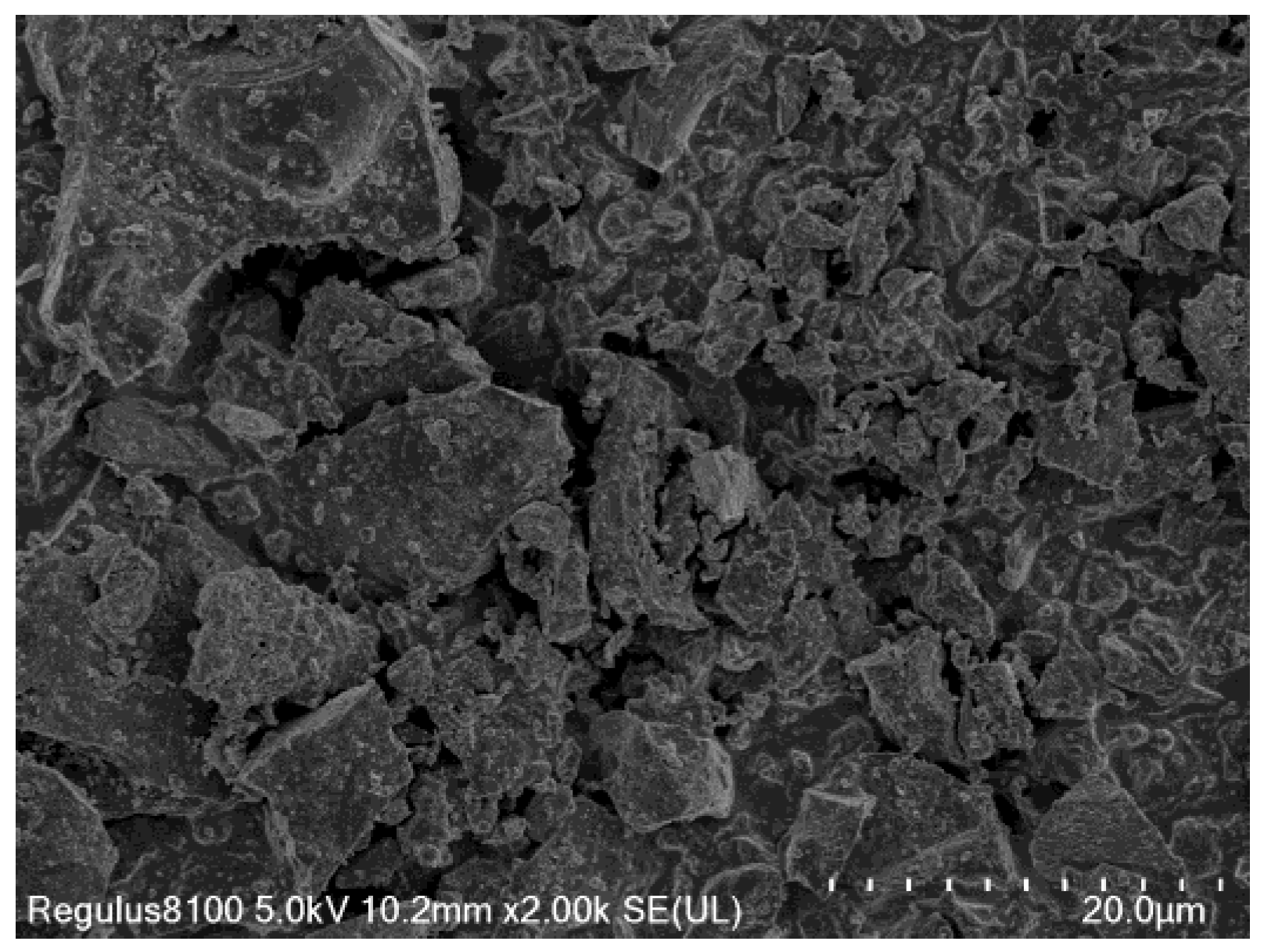
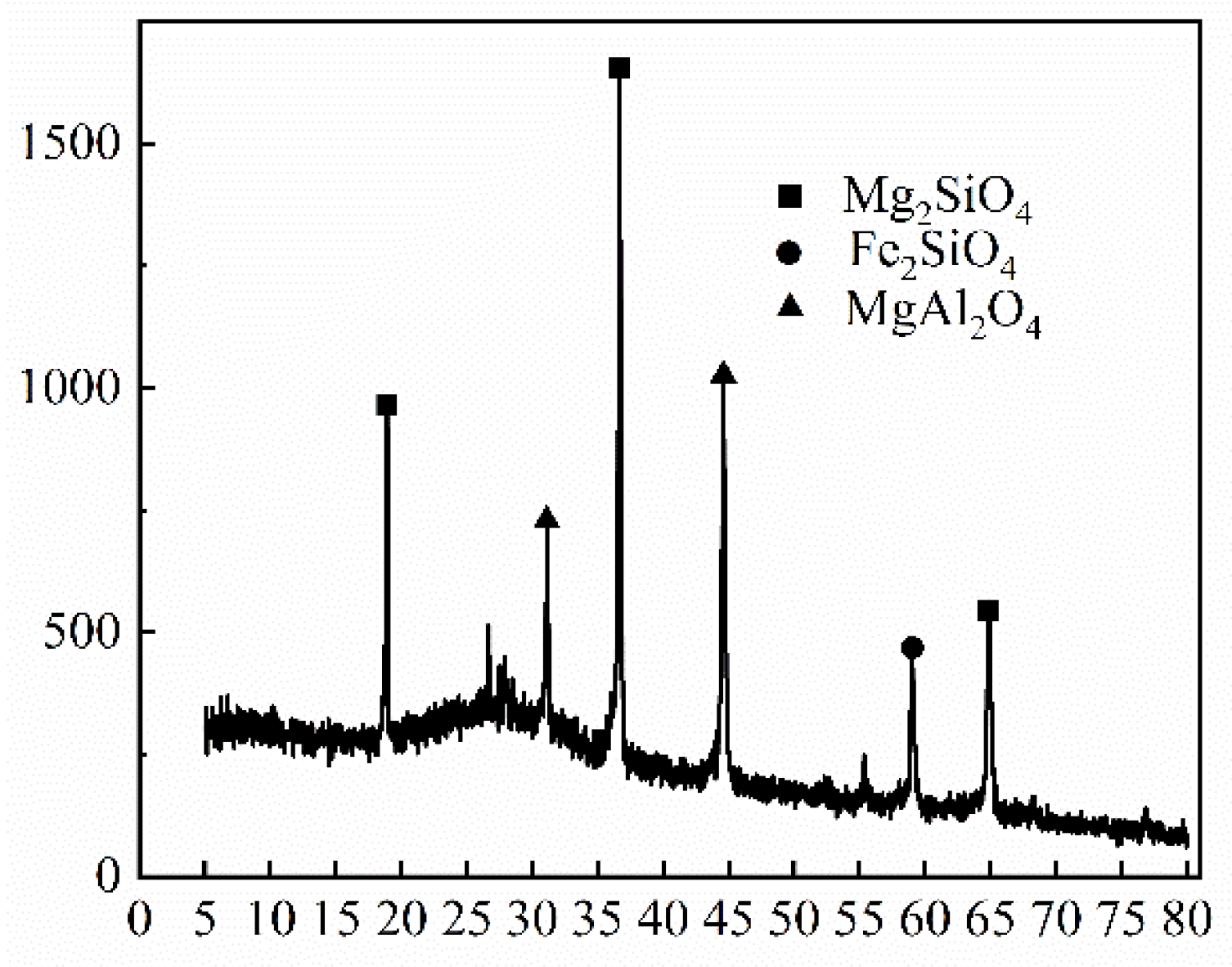
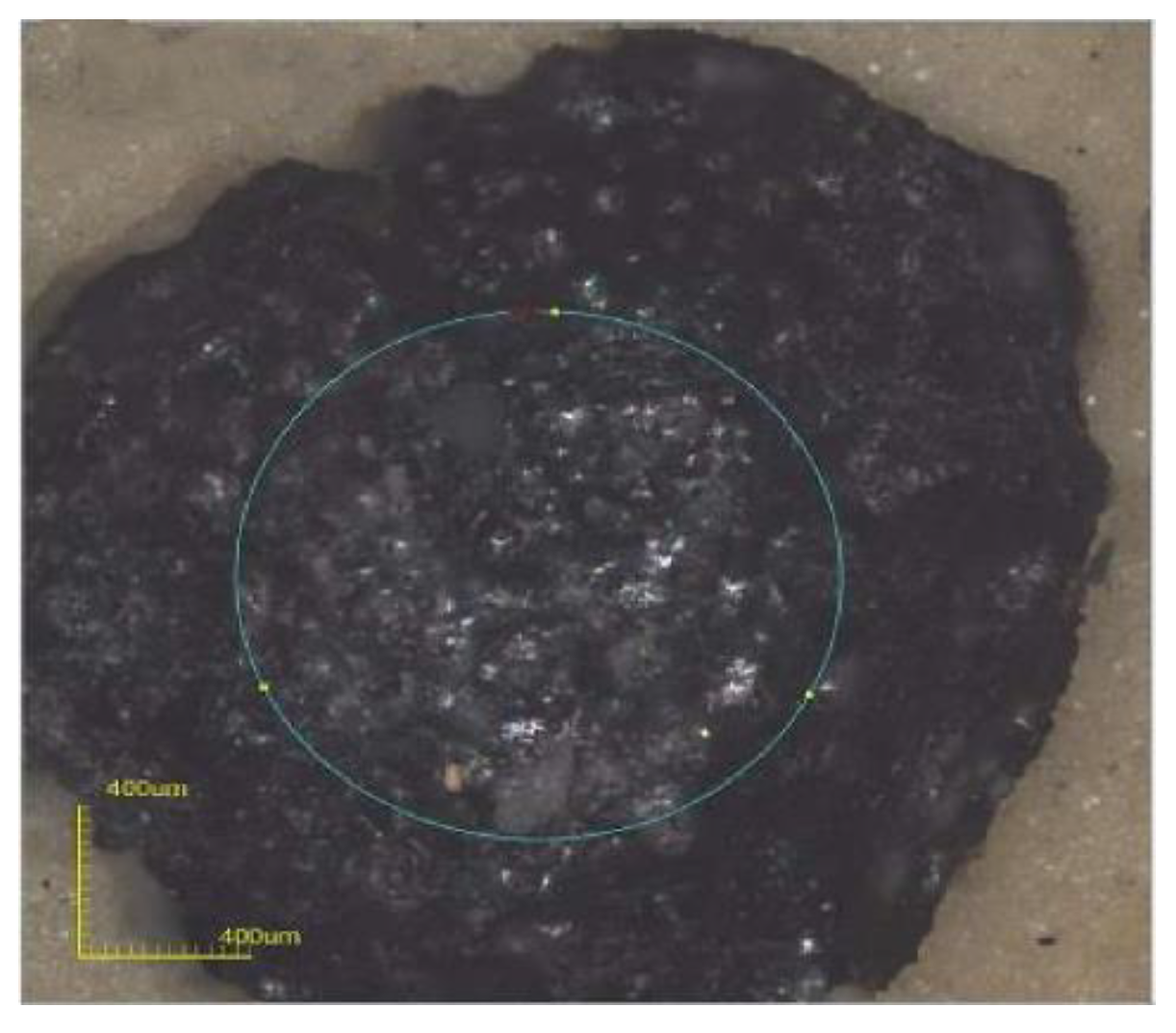
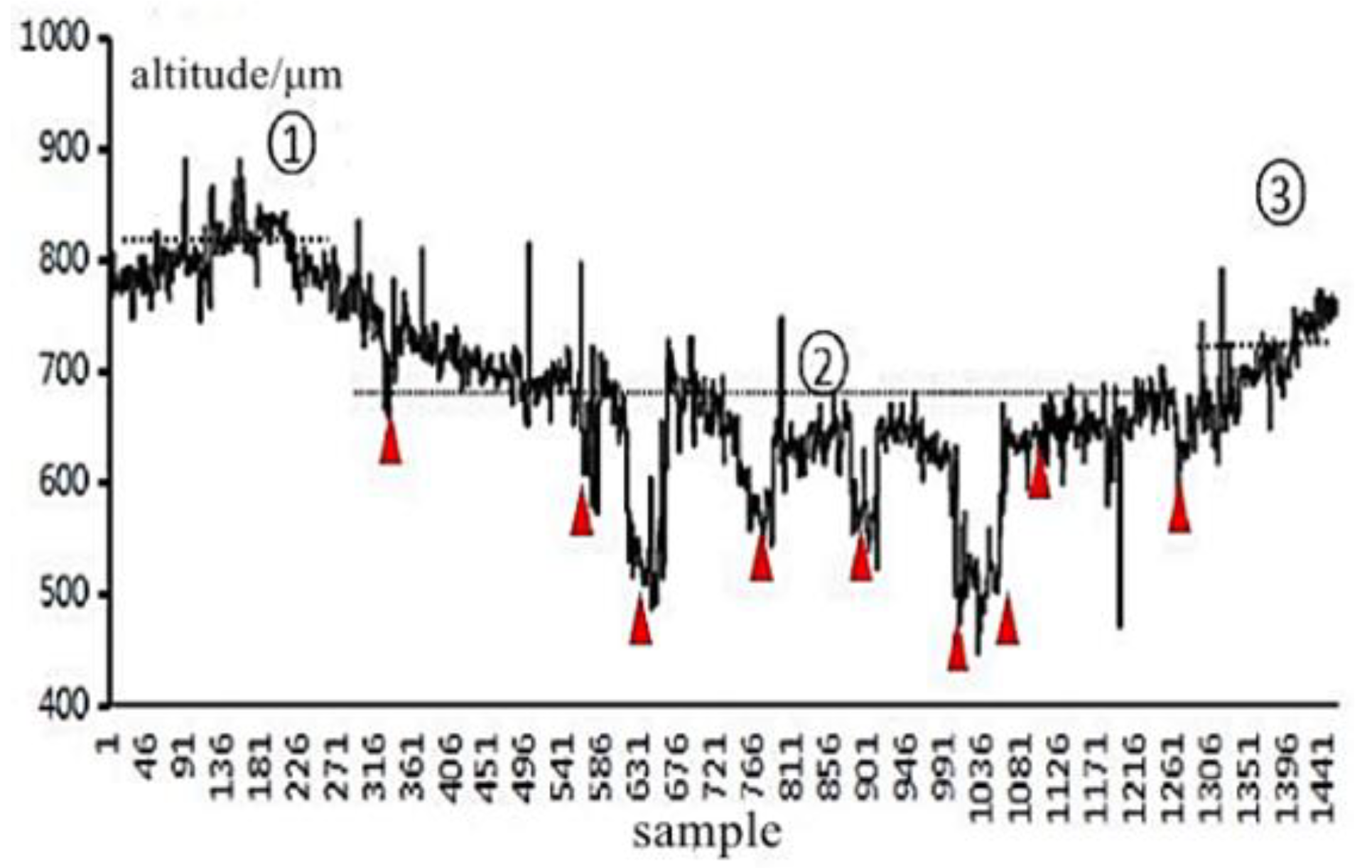
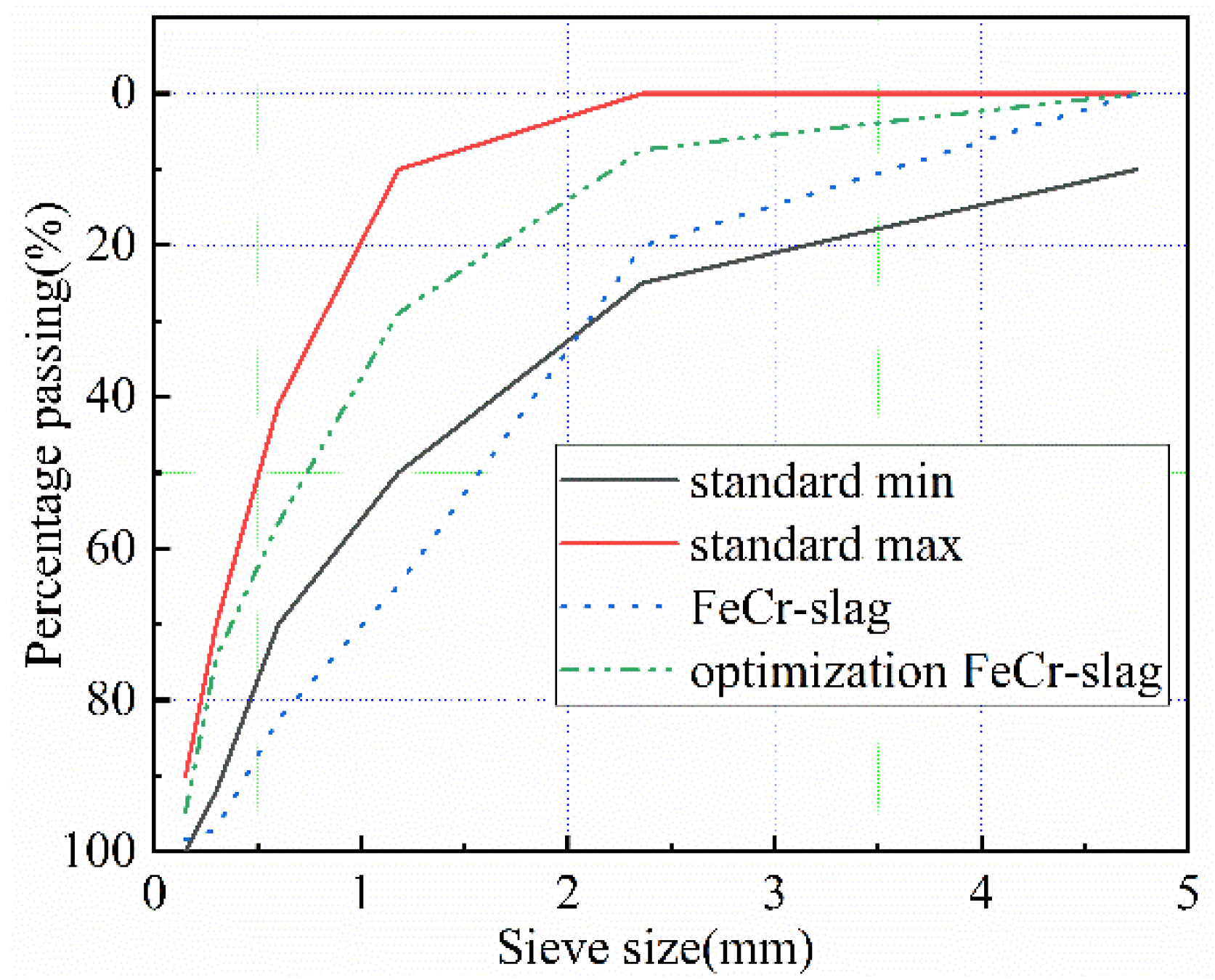
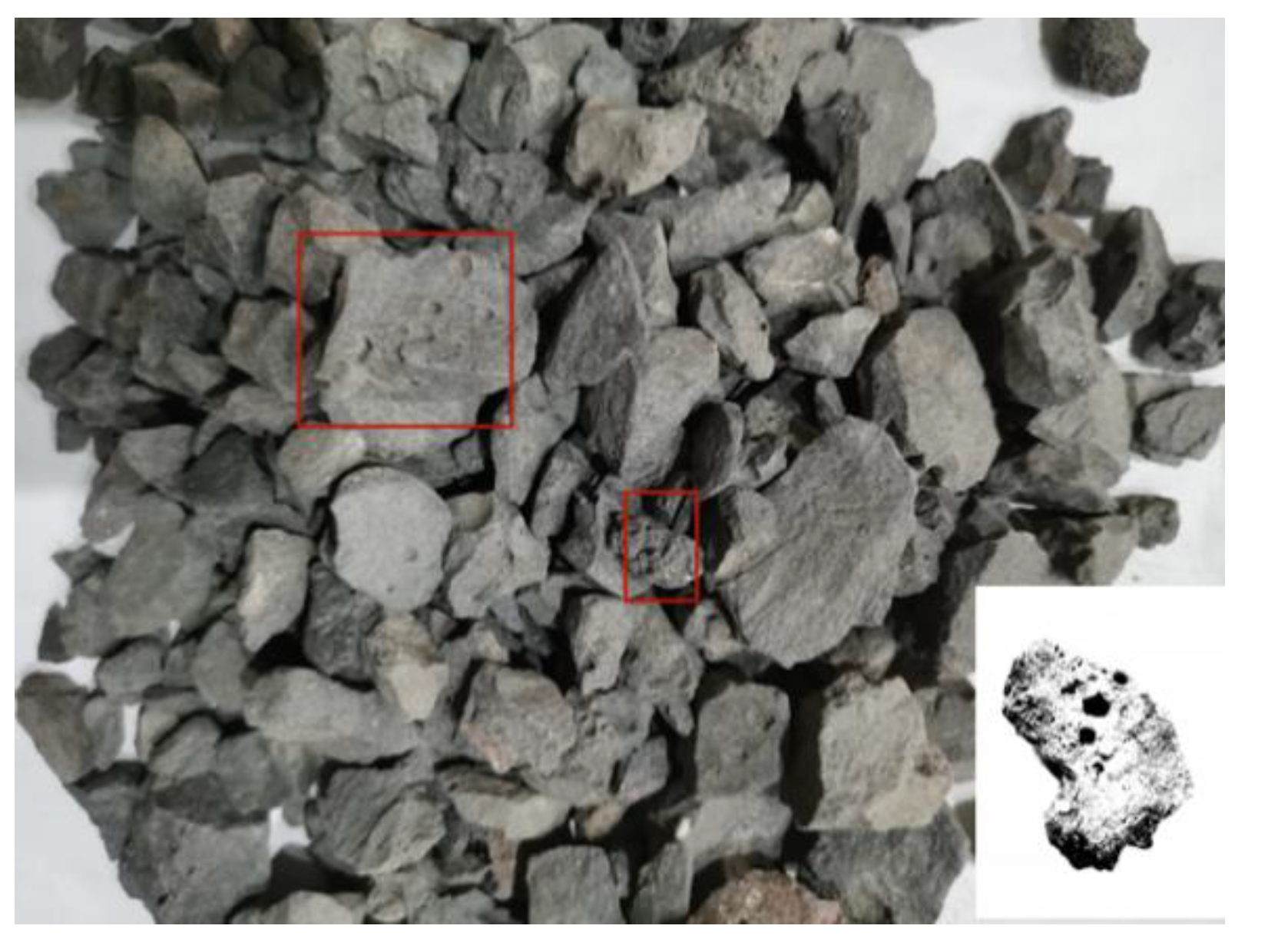

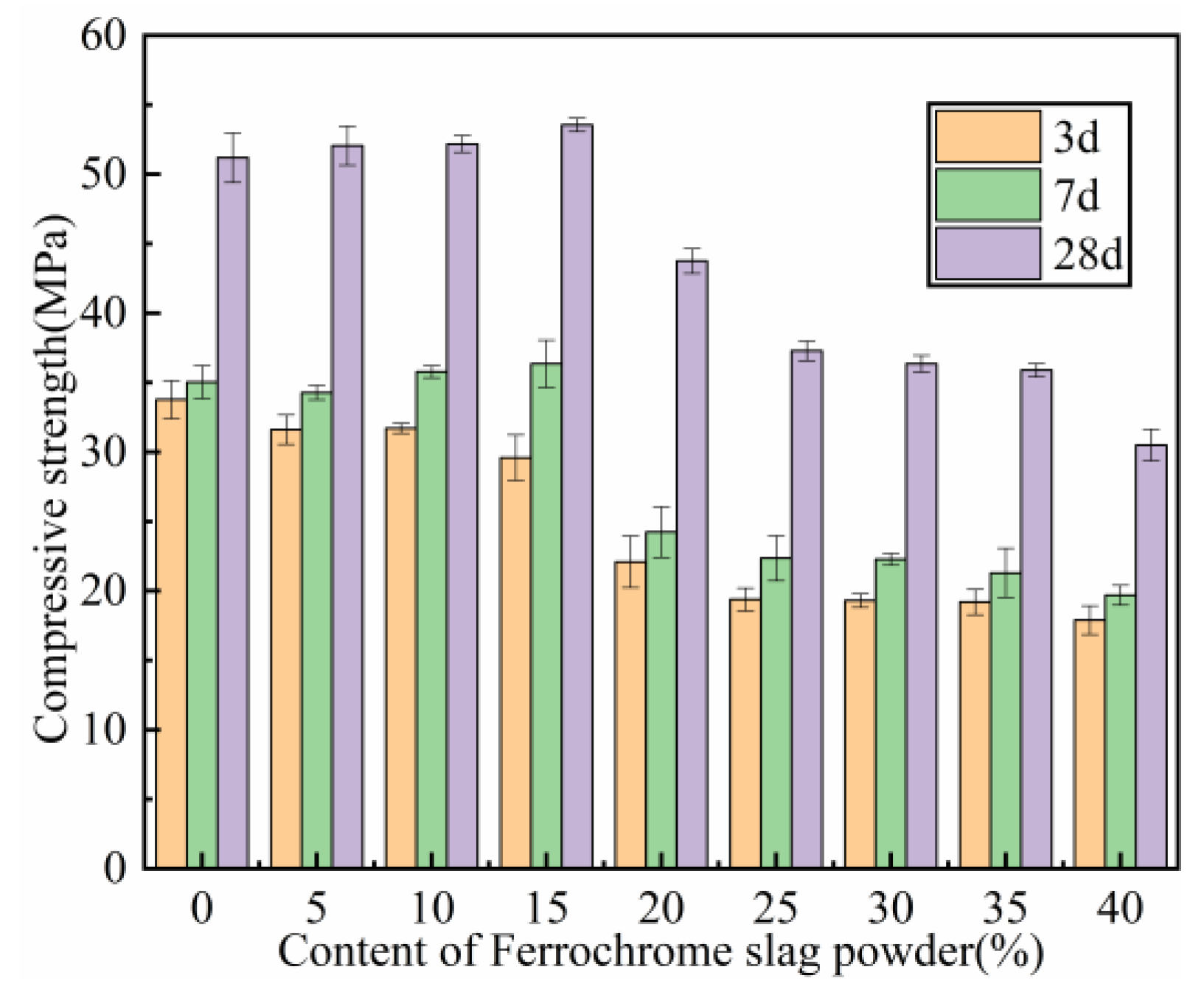
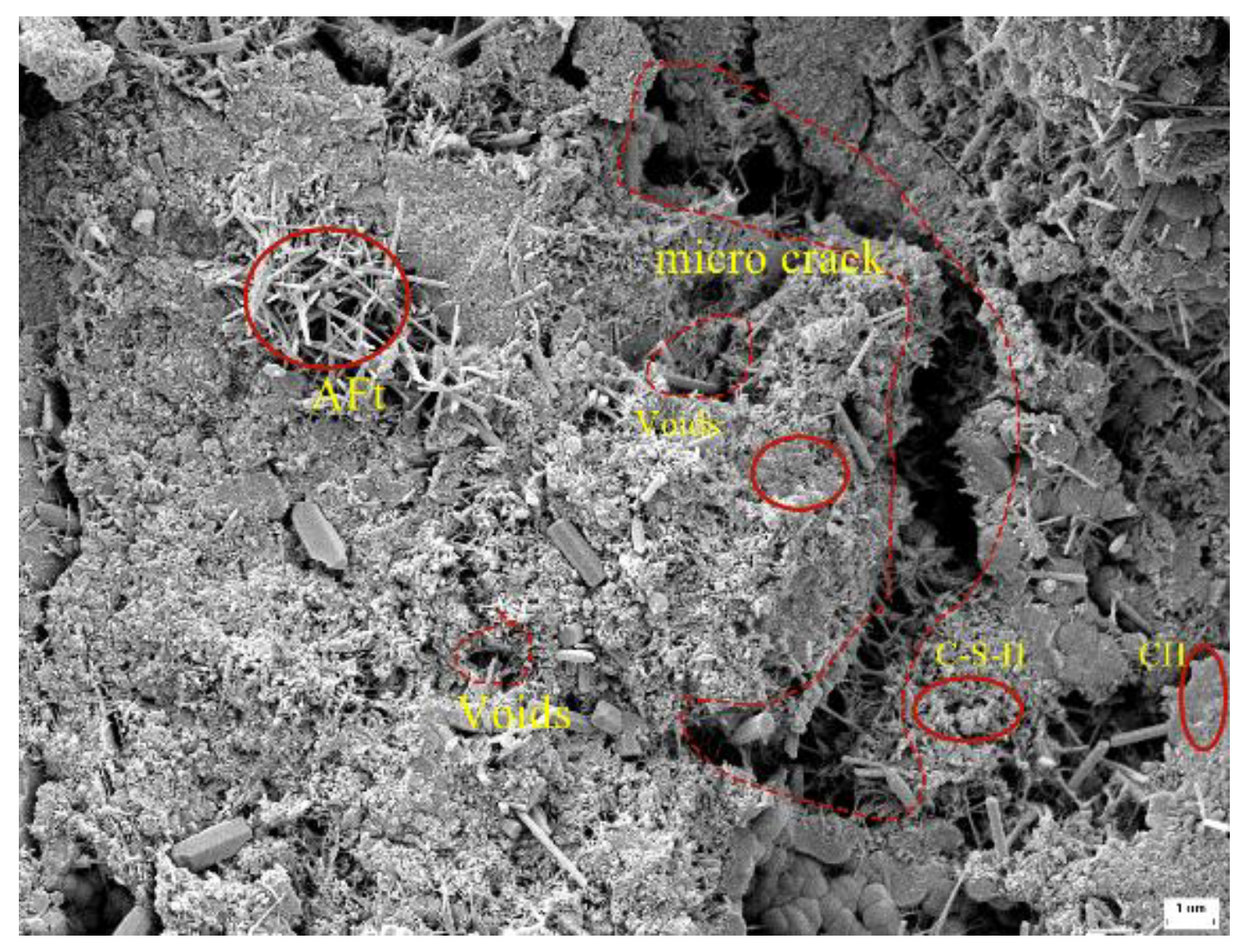
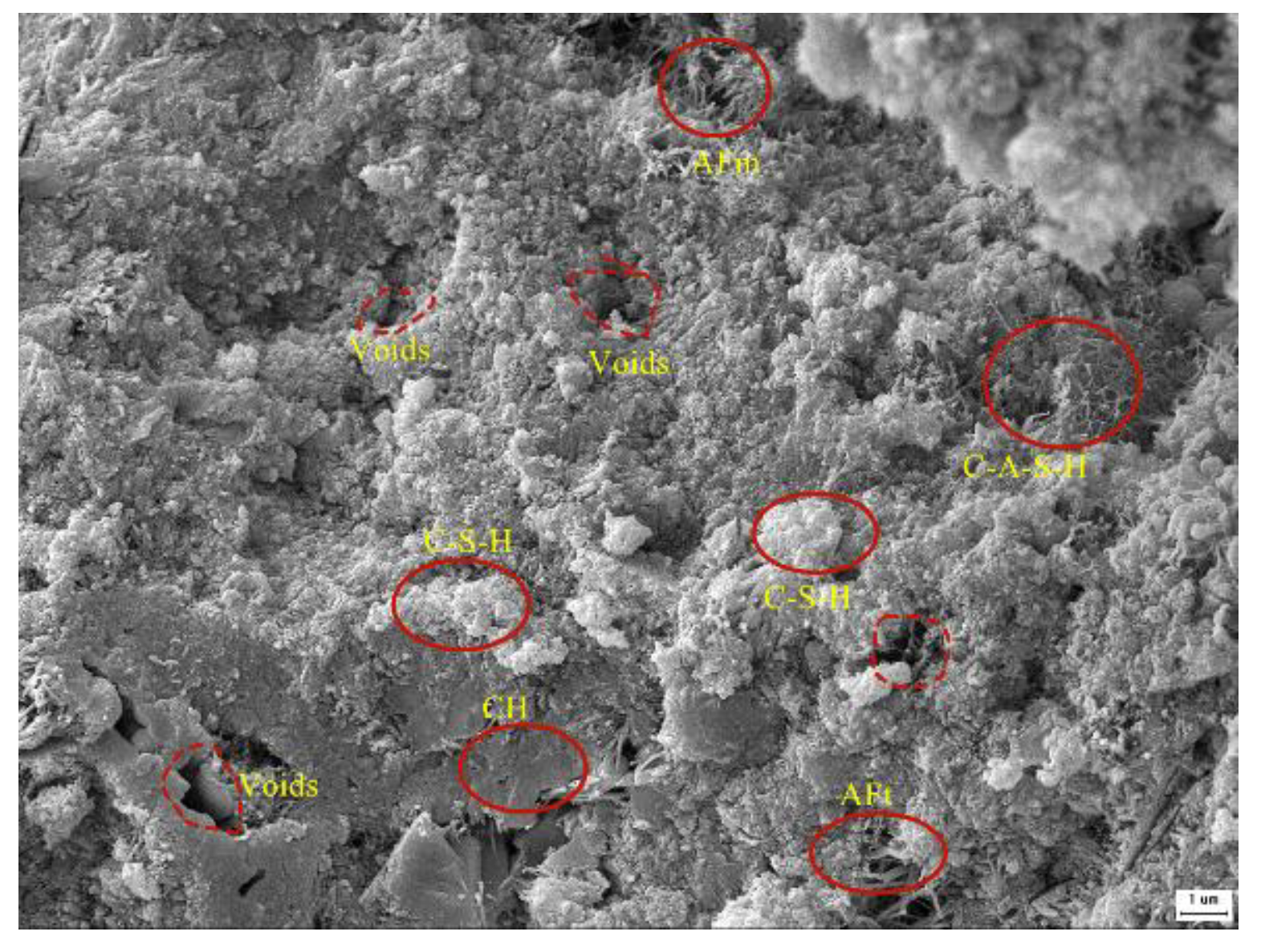
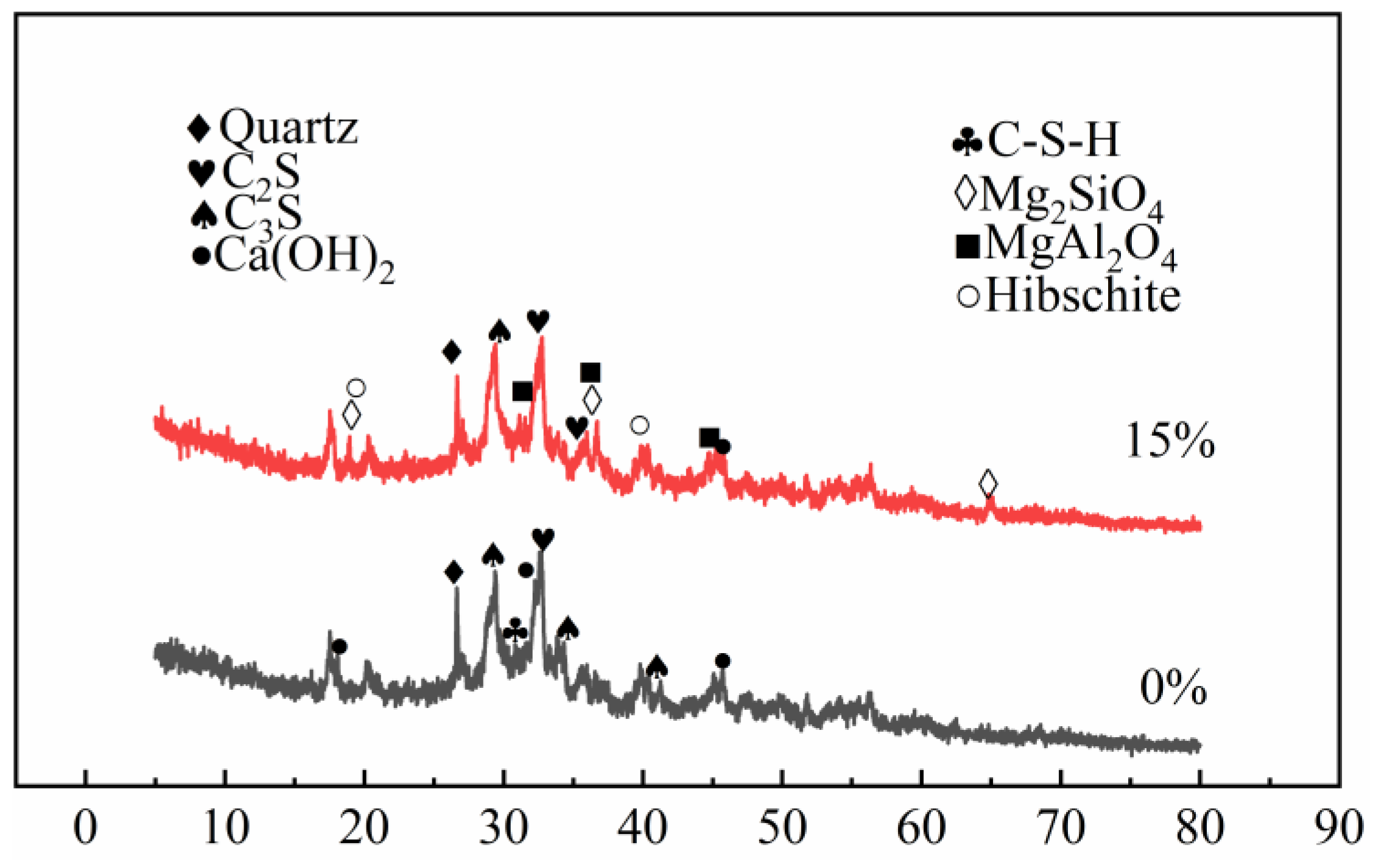
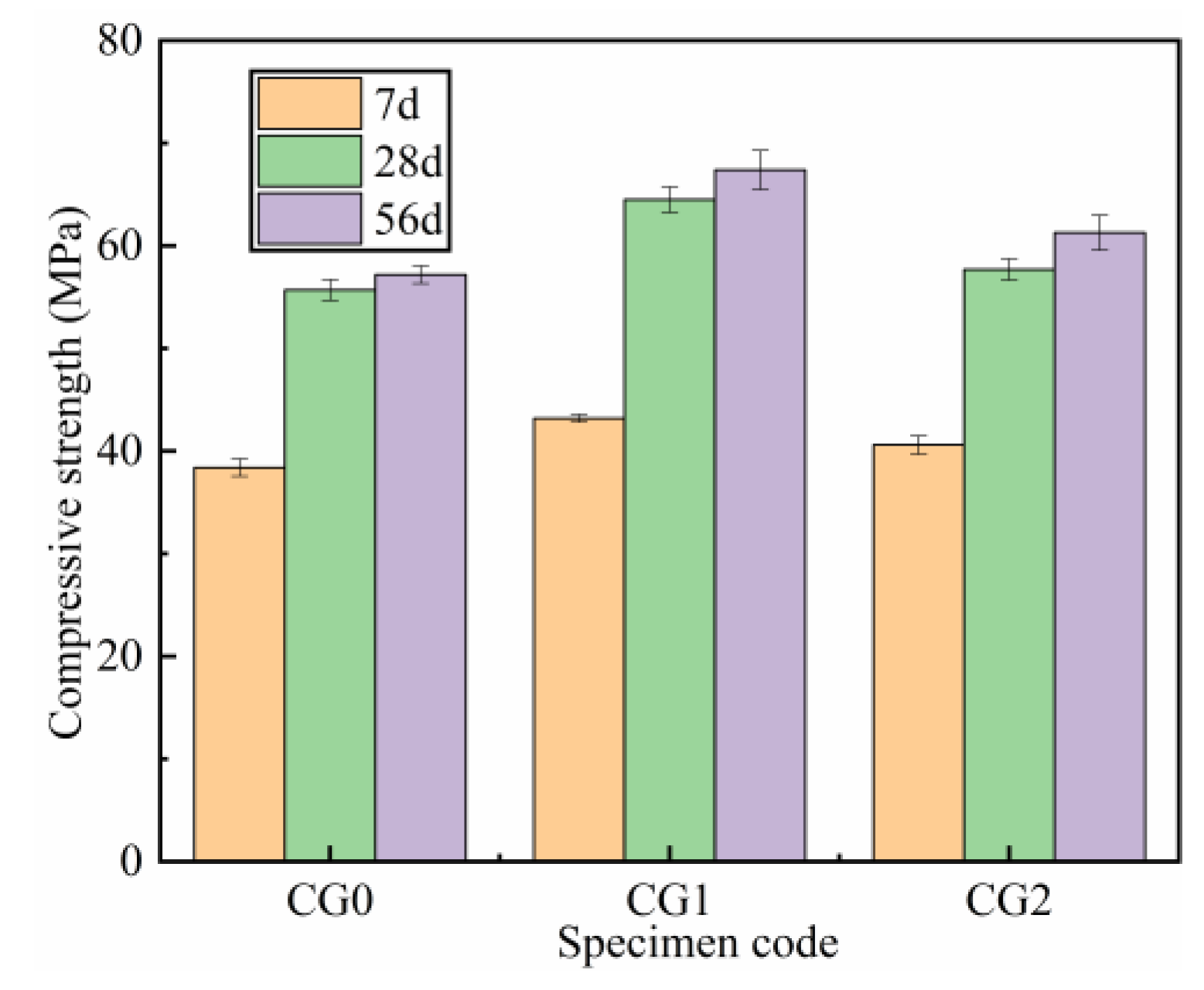
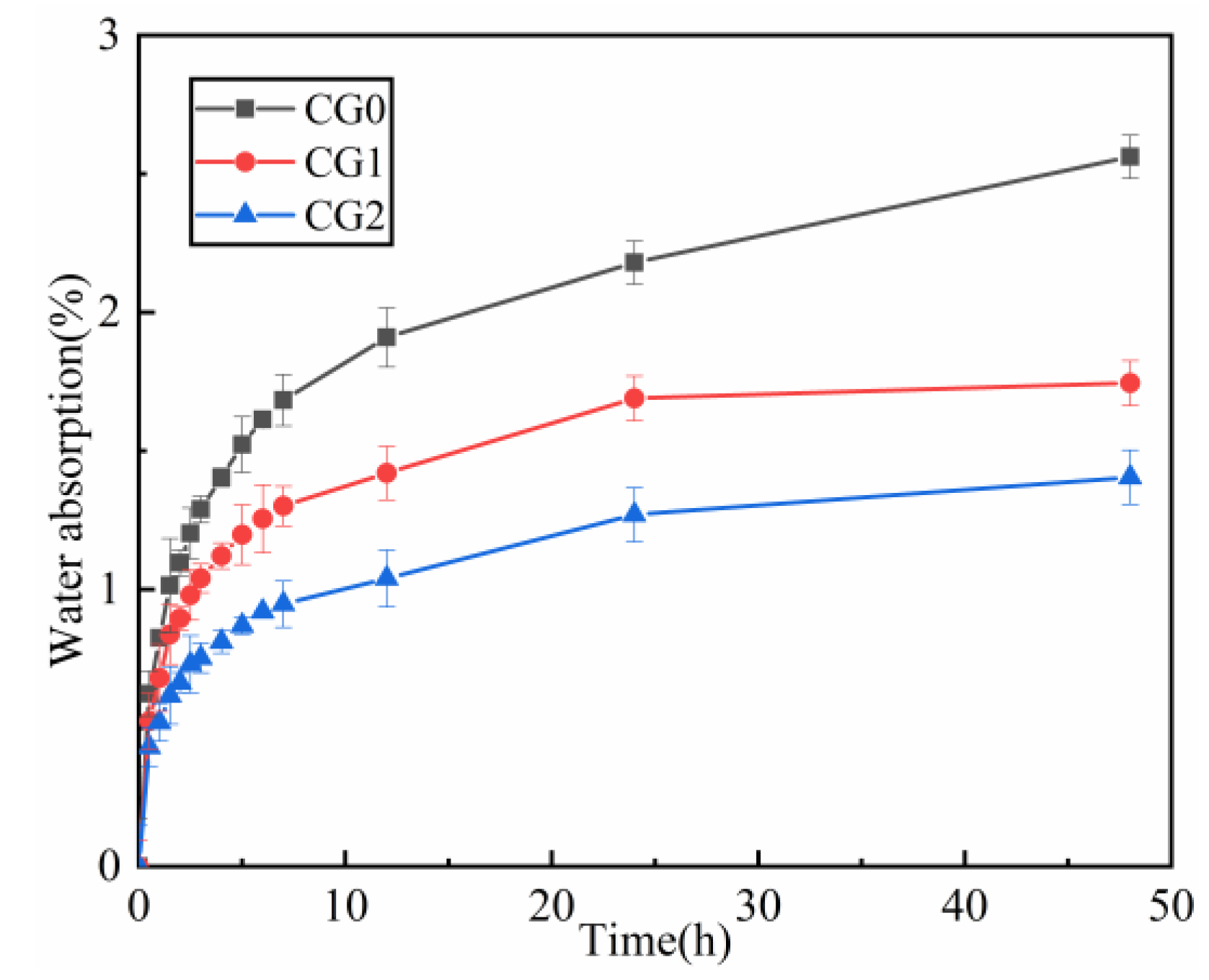
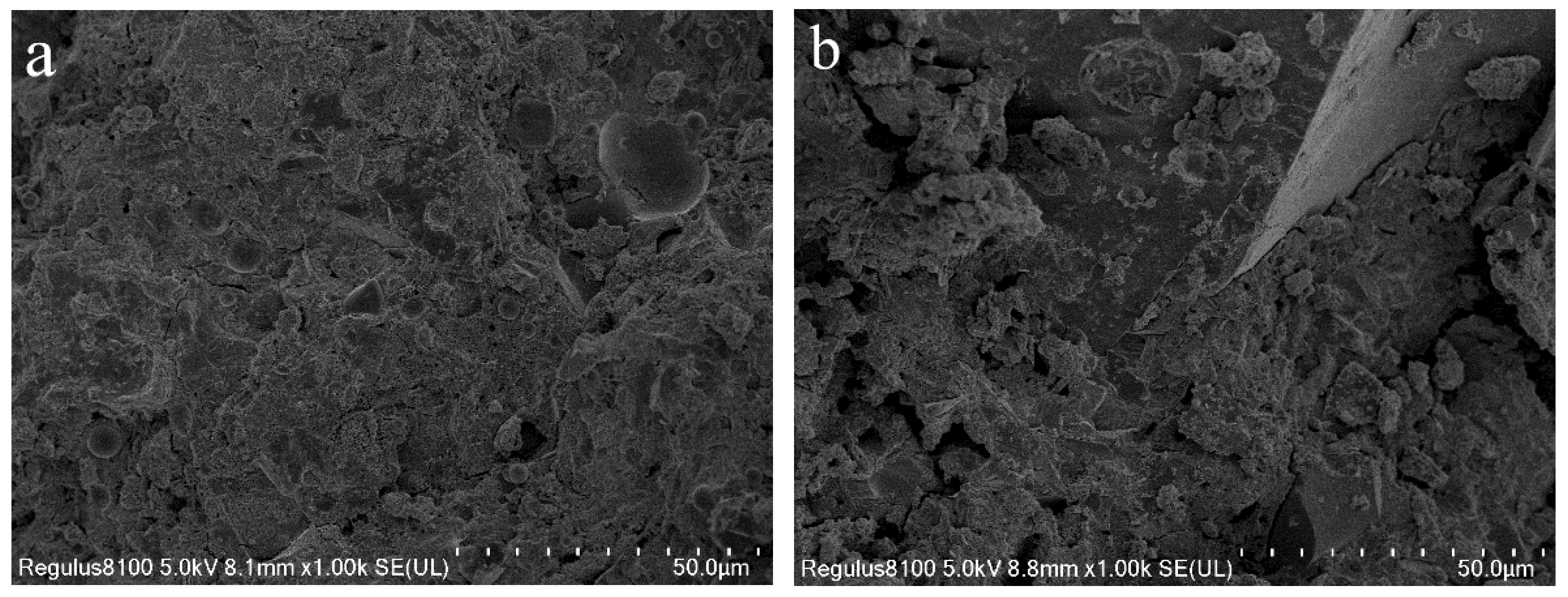

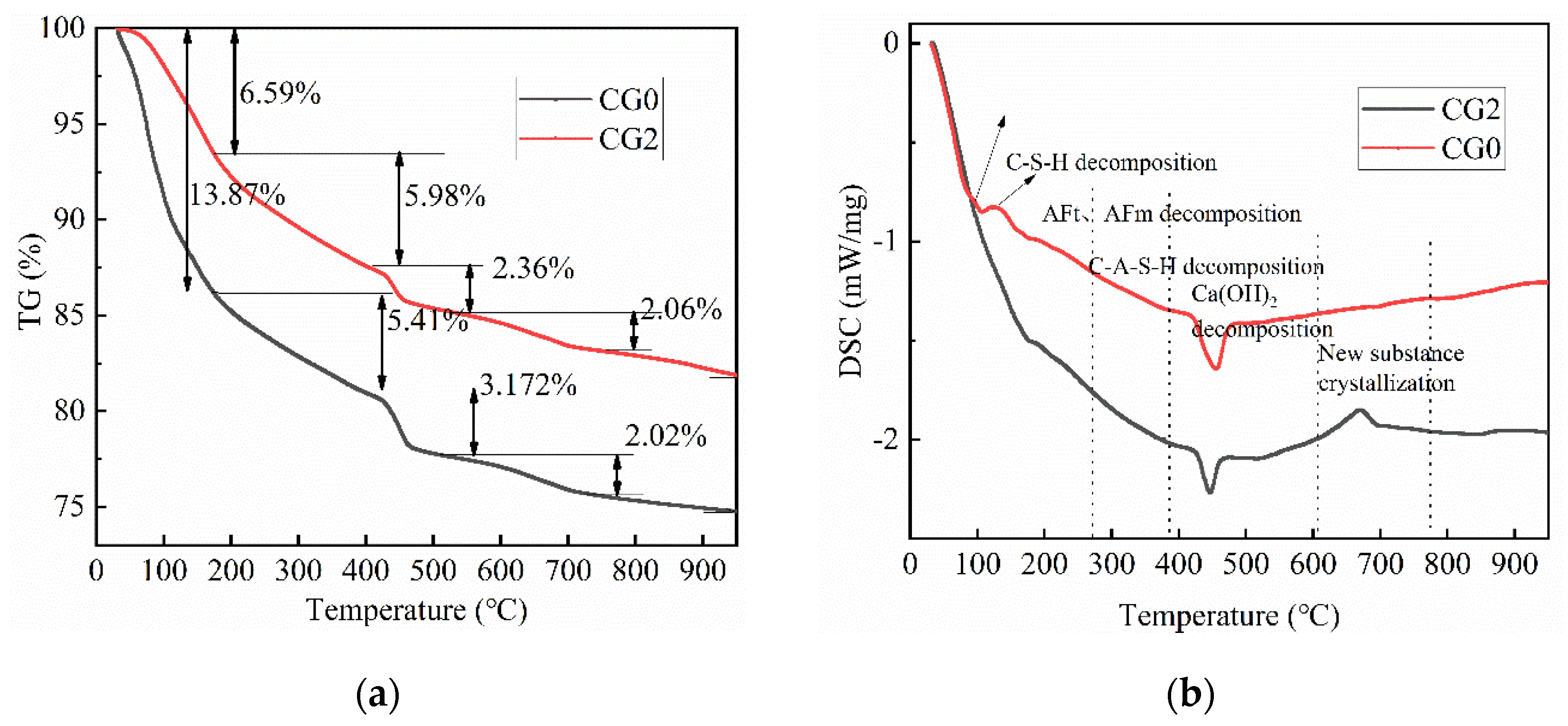
| Constituents | SiO2 | Al2O3 | Fe2O3 | CaO | MgO | SO3 | Cr2O3 |
|---|---|---|---|---|---|---|---|
| Cement | 26.30% | 9.63% | 3.69% | 55.43% | 2.10% | 1.23% | - |
| Ferrochrome slag | 28.26% | 32.31% | 3.08% | 3.34% | 27.62% | 0.75% | 3.82% |
| Initial Setting Time/(min) | Final Setting Time/(min) | Specific Surface/(m2/kg) | Consistency /% | Compressive Strength/MPa | ||
|---|---|---|---|---|---|---|
| 3 d | 28 d | |||||
| OPC | 164 | 220 | 382.4 | 25.4 | 32.7 | 48.3 |
| Specific Gravity/Kg·m−3 | Bulk Density/Kg·m−3 | Porosity /% | Fineness Modulus | Water Absorption /% | |
|---|---|---|---|---|---|
| Natural sand | 2609 | 1620 | 37.9 | 2.6 | 0.8 |
| FeCr slag | 2836 | 1447 | 49 | 3.6 | 3.1 |
| Specific Gravity/Kg·m−3 | Bulk Density/Kg m−3 | Porosity % | Gradation | Crushing Value/% | |
|---|---|---|---|---|---|
| NCA | 2780 | 1660 | 40.3 | continuous | 8 |
| FeCr slag | 3073 | 1487 | 51.6 | continuous | 12.1 |
| Specimen Code | OPC | FA | Fine Aggregate | CA | Water | PC | Slump | Density | |
|---|---|---|---|---|---|---|---|---|---|
| FeCr | NFA | ||||||||
| CG0 | 345 | 60 | 770 | 1114 | 160 | 8.1 | 205 | 2484 | |
| CG1 | 345 | 60 | 308 | 462 | 1114 | 160 | 8.1 | 200 | 2537 |
| CG2 | 345 (15% FeCr) | 60 | 308 | 462 | 1114 | 160 | 8.1 | 190 | 2553 |
Disclaimer/Publisher’s Note: The statements, opinions and data contained in all publications are solely those of the individual author(s) and contributor(s) and not of MDPI and/or the editor(s). MDPI and/or the editor(s) disclaim responsibility for any injury to people or property resulting from any ideas, methods, instructions or products referred to in the content. |
© 2022 by the authors. Licensee MDPI, Basel, Switzerland. This article is an open access article distributed under the terms and conditions of the Creative Commons Attribution (CC BY) license (https://creativecommons.org/licenses/by/4.0/).
Share and Cite
Hang, M.; Wang, J.; Zhou, X.; Sun, M. Design and Study of Physical and Mechanical Properties of Concrete Based on Ferrochrome Slag and Its Mechanism Analysis. Buildings 2023, 13, 54. https://doi.org/10.3390/buildings13010054
Hang M, Wang J, Zhou X, Sun M. Design and Study of Physical and Mechanical Properties of Concrete Based on Ferrochrome Slag and Its Mechanism Analysis. Buildings. 2023; 13(1):54. https://doi.org/10.3390/buildings13010054
Chicago/Turabian StyleHang, Meiyan, Jiechao Wang, Xuebin Zhou, and Mengjie Sun. 2023. "Design and Study of Physical and Mechanical Properties of Concrete Based on Ferrochrome Slag and Its Mechanism Analysis" Buildings 13, no. 1: 54. https://doi.org/10.3390/buildings13010054
APA StyleHang, M., Wang, J., Zhou, X., & Sun, M. (2023). Design and Study of Physical and Mechanical Properties of Concrete Based on Ferrochrome Slag and Its Mechanism Analysis. Buildings, 13(1), 54. https://doi.org/10.3390/buildings13010054







